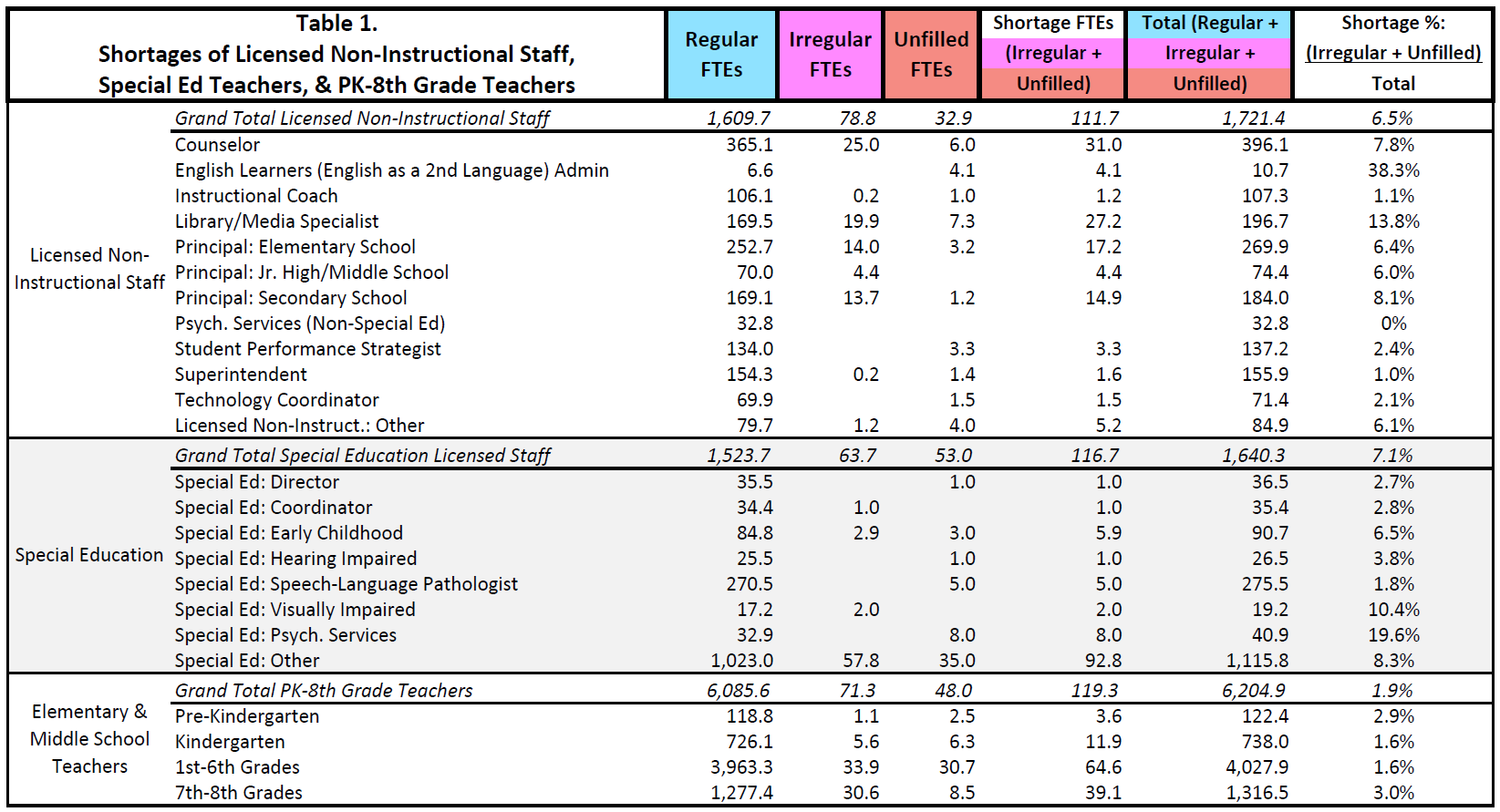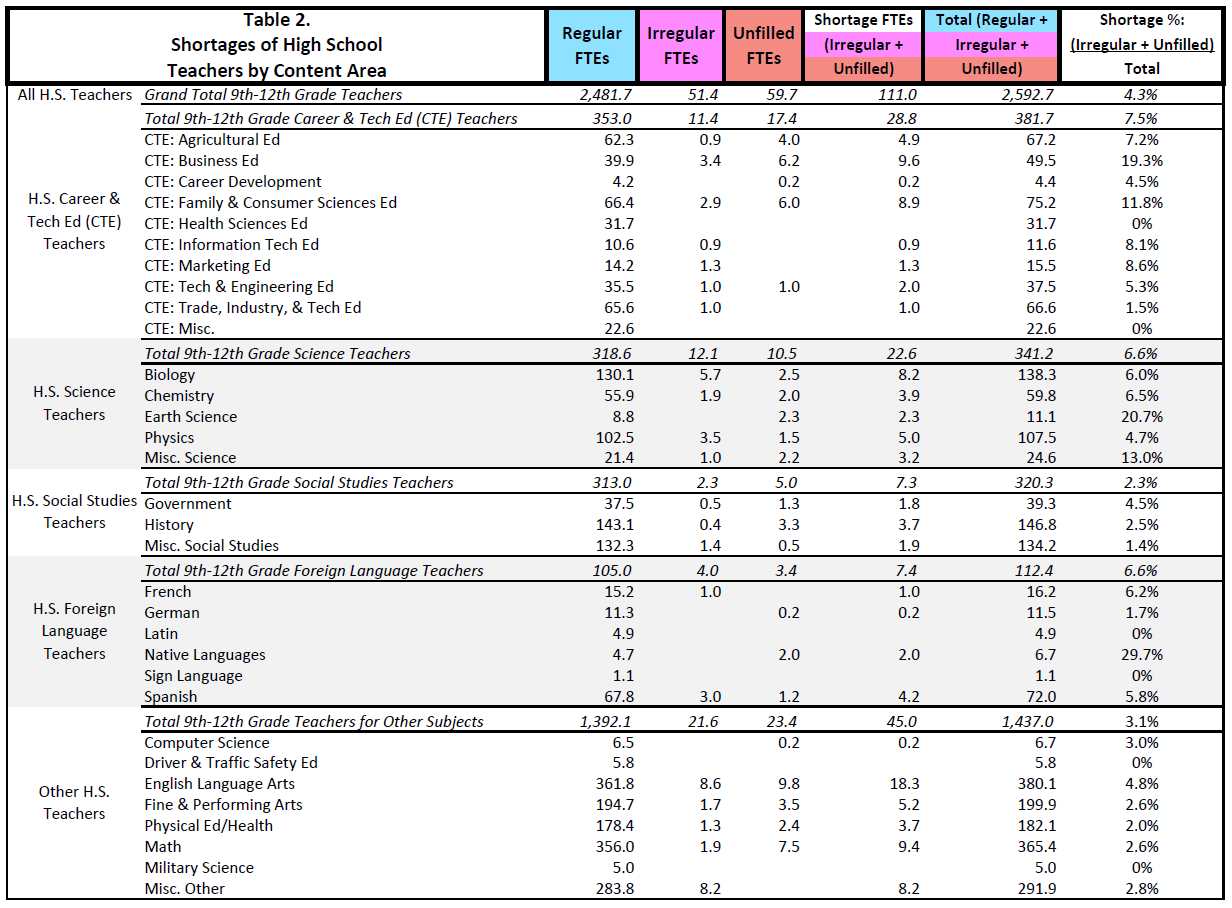15 Jan North Dakota’s Teacher Shortage Illuminated by Continued K-12 & University System Collaboration
In a past blog entry, I explained how my service to the ND University System includes providing K-12 research support to the ND Department of Public Instruction. As our collaborative arrangement continues to succeed, I’m able to work on fascinating projects. One such project is the Teacher Shortage Areas reporting. This reporting is used at state and federal levels to identify the finer details of teacher shortages. As the details reveal which grade levels and content areas have the greatest teacher shortages, the information can in turn be used by state and federal governments to provide student loan forgiveness to select teachers.
Loan forgiveness aside, the nuances of ND’s teacher shortage are interesting in their own right. In order to understand teacher shortages, it’s first necessary to understand how many teachers are working and how many teaching positions are unfilled. It is also key to know how many working teachers are certified in regular or irregular ways. Teachers with regular certification have a typical teaching license and any credentials or endorsements relevant to their content areas. Teachers with irregular certification may be certified by provisional, temporary, or emergency certification. Teachers with irregular certification may also be teaching in academic subject other than their area of preparation. Altogether, a teacher shortage is understood as proportion of unfilled and irregularly filled teaching positions relative to all teaching positions.
Importantly, some teachers work full-time while others work part-time. For this reason, I use full-time equivalencies (FTEs) for my analyses. This means that a full-time teacher is counted as 1 position, a half-time teacher is counted as .5 of a position, and so on.
Let’s now dive into the data. In Table 1, first we see the shortages for non-instructional staff. These are administrators and others who help teachers and students, but do not offer regular classroom instruction. We can see that the shortage looks quite different across these positions.

For example, there are 196.7 library/media specialist positions in ND. Of these FTEs, 169.5 are filled by regularly certified library/media specialists, 19.9 are filled by irregularly certified library/media specialists, and 7.3 are unfilled. This means that the size of the shortage is 27.2 FTEs, which is 13.8% of all library/media specialist positions. In this case, the shortage is driven more by irregular certification than it is by unfilled positions.
Let’s consider another example from Table 1. Special education teachers belonging to the broad “other” category have a whopping shortage of 92.8 FTEs. Due to the large number of total positions (1,115.8 FTEs), this shortage percentage within this category is 8.3%.
Let’s consider some more examples. Also in Table 1, you can see that shortages of Pre-Kindergarten through 8th grade teachers are low in terms of percentage, but high in some cases in terms of raw FTEs. Do high school teachers show similar trends? The answer is complicated. See Table 2, which focuses on high school teachers.

It’s clear that high school teacher shortages vary significantly by content area. For instance, the physical education/health teacher shortage is quite modest at 2% (and 3.7 FTEs). The earth science teacher shortage is proportionately large at 20.7%, but this represents only 2.3 unfilled FTEs. Career and technical education (CTE) teachers as a whole have a large shortage of 28.8 FTEs, but the magnitude of the shortage is only 7.5% within this broad category.
However, we see that it is very useful to break down high school CTE teachers by specialization. For instance, we see no evidence of a teacher shortage when it comes to health sciences education. However, business education has a notable shortage of 19.3% (9.6 FTEs).
When seeking to understand the ND teacher shortage – especially when considering policy solutions – it’s key to look at shortages within content areas and grade levels. When equipped with detailed data, stakeholders and decision-makers can craft nuanced solutions to our nuanced problem.
============================================================================
 Dr. Ellie Shockley is an Educational Data Warehouse Specialist on the NDUS institutional researcher team. In this capacity, she also works closely with the Department of Public Instruction (PK-12) and the Information Technology Department. She often responds to education data requests that come from state agencies or from outside of state government. Her work ranges from pulling raw data and sharing it according to our best practices, to conducting complex statistical analyses in order to answer research questions, to assisting with inter-agency collaborations related to education data, and more. Dr. Ellie Shockley is an Educational Data Warehouse Specialist on the NDUS institutional researcher team. In this capacity, she also works closely with the Department of Public Instruction (PK-12) and the Information Technology Department. She often responds to education data requests that come from state agencies or from outside of state government. Her work ranges from pulling raw data and sharing it according to our best practices, to conducting complex statistical analyses in order to answer research questions, to assisting with inter-agency collaborations related to education data, and more. |


